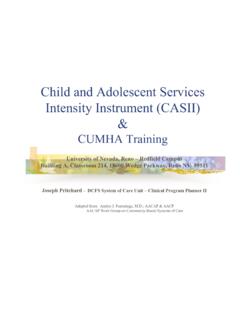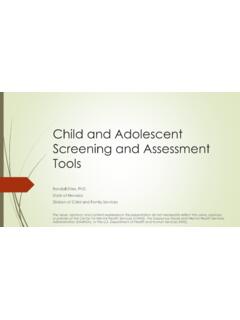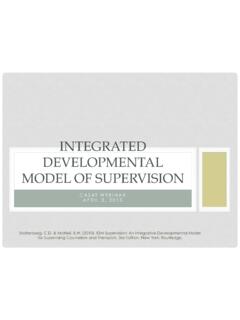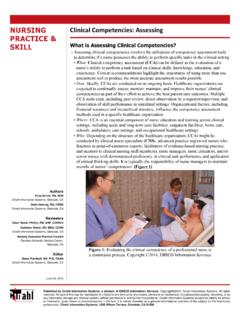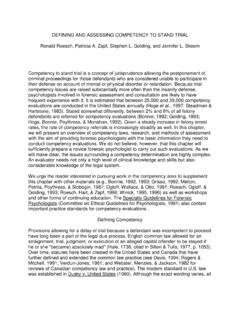Transcription of The Child Behavior Checklist and Related Forms for ...
1 The Child Behavior Checklist and Related Forms forAssessing behavioral / emotional Problems andCompetenciesThomas M. Achenbach, PhD,* and Thomas M. Ruffle, MD OBJECTIVES:After completing this article, readers should be able to:1. List the types of behavioral and emotional problems that primarycare physicians who work with children must Describe the data required from parents, children, teachers, andchild care practitioners for assessment of behavioral and Describe systems of questionnaires that can be used for obtainingstandardized assessment care physicians who workwith children must deal with a greatvariety of behavioral and emotionalproblems. The system described inthis article provides low-cost, stan-dardized assessment and documenta-tion of such problems and requireslittle effort by the care physicians are underincreasing pressure to obtain stan-dardized documentation for the con-ditions they encounter.
2 The mostobvious pressures stem from man-aged care. Among the most fre-quently imposed expectations ofprimary care physicians are to:cBe gatekeepers for most Forms ofcare needed by increasingly diverse servicesto more patients while limiting thetime spent with each extensive documentationfor assessments of patients and fortreatment and fulfill these expectations, physi-cians need cost-effective proceduresfor obtaining, using, and transmit-ting information about s behavioral and emo-tional problems pose special chal-lenges for meeting such managedcare requirements. Certain types ofbehavioral problems, such as thoseascribed to attention deficit hyperac-tivity disorder (ADHD), are widelypublicized as candidates for medicalmanagement. Concerned parents,therefore, may request that pediatri-cians and family practitioners evalu-ate their children for ADHD.
3 Toassess ADHD and other behavioraland emotional problems, physiciansneed information from people whosee children in their everyday con-texts. Parents and parent-surrogatesare the primary sources of suchinformation for most children. Olderchildren can contribute useful infor-mation about their own are especially importantsources of information when chil-dren s functioning in school is rele-vant, such as when ADHD are no litmus tests to deter-mine precisely which children havebehavioral or emotional , even when a Child sbehavior is clearly problematic,detailed documentation is needed topinpoint the specific areas in whichthe Child s Behavior deviates fromnorms for age and gender. Suchdocumentation is needed for decid-ing what action to take, advisingparents, communicating with mentalhealth and special education person-nel, and referring to Child BehaviorChecklist (CBCL)The CBCL is a standardized formthat parents fill out to describe theirchildren s behavioral and emotionalproblems.
4 The version of the CBCLfor ages 2 and 3 years (CBCL/2 to3) can be completed by parents inabout 10 minutes. The version forages 4 to 18 years (CBCL/4 to18) includes competence items andproblems. The problem items can becompleted by most parents in about10 minutes, and the (optional) com-petence items require an additional5 to 10 minutes. The CBCL is self-explanatory and can be filled out ina waiting room or can be sent homefor completion. If a parent is unableto complete the CBCL indepen-dently, a receptionist or other staffmember can read the items aloudand enter the parent s answers whilethe parent follows along on a secondcopy. For parents whose Englishskills are poor but who can readother languages, translations areavailable in 58 1 shows the CBCL/2 to 3filled out for 3-year-old Adam Sternby his mother.
5 For each problemitem, parents circle 0 if the item isnot true of their Child , 1 if the itemis somewhat or sometimes true, and2 if the item is very true or oftentrue. problem items on the CBCL/4 to 18 resemble those on theCBCL/2 to 3, except that parentsrate the CBCL/4 to 18 problemitems for the preceding 6 monthsinstead of the 2 months specified onthe CBCL/2 to 3. Competence itemson the CBCL/4 to 18 assess thechild s activities, social relations,and school data obtained with the CBCLare summarized on a profile thatdisplays the parent s ratings of eachitem. The profile also displays thechild s standing on syndromes ofproblems that were derived fromstatistical analyses of CBCLs filledout for large numbers of clinicallyreferred children. Each syndromeconsists of problems that were foundto occur concomitantly.
6 Figure 2displays the profile for Adam Sternthat was scored from the CBCL/2 to3 filled out by his mother.*Departments of Psychiatry and Psychology,University of Vermont, Burlington, VT. Vermont Child Development Clinic,Burlington, in ReviewVol. 21 No. 1 August 2000265As illustrated in Figure 2, theCBCL/2 to 3 syndromes are desig-nated in six areas: anxious/de-pressed, withdrawn, sleep problems,somatic problems, aggressive behav-ior, and destructive s score on each syndromeconsists of the sum of numbers thathis mother circled on the individualitems that comprise the left side of the profile delin-eates the percentile of the nationalnormative sample for each syndromescore. For example, Adam s scoreon the anxious/depressed syndromeis at the 69th percentile, whichmeans that 69% of the children inthe national normative sampleobtained scores at or below thescore that Adam AND CLINICALRANGESThe broken lines on the profileshown in Figure 2 indicate a border-line range between the normal andclinical ranges.
7 Scores that arebelow the bottom broken line (95thpercentile) are in the normal range,and those that are above the top bro-ken line (98th percentile) are in theclinical range. Scores between thebroken lines are high enough to beof concern, but not high enough tobe considered very deviant. Adamobtained scores in the borderlinerange on the sleep problems andsomatic problems syndromes, but inthe clinical range on the aggressivebehavior syndrome. The profile inFigure 2 documents that Ms. Sternreported considerably more aggres-sive Behavior for Adam than isreported by parents of most 3-year-olds as well as somewhat moresleep problems and somatic prob-lems without known medical borderline and clinical rangesshown on the profiles provide guide-lines for identifying scores that aremoderately to very deviant com-pared with scores obtained by nor-mative samples of children s guidelines are flexible in thatusers can tailor their choice of cut-points to their particular caseloadsand to the types of decisions neededin individual cases.
8 For example,users may elect to apply lower cut-points to scores on the anxious/de-pressed, aggressive Behavior , anddestructive Behavior scales of theCBCL/2 to 3 and to scores on theattention problems scale of theCBCL/4 to 18. Because these syn-dromes comprise large numbers ofpotentially troublesome problems,lower cutpoints often may be war-ranted than for syndromes that com-prise fewer and less troublesomeproblems. Furthermore, scores thatfail to reach cutpoints may indicatea need for diagnostic evaluations forconditions such as anxiety disorders,depression, oppositional-defiant dis-order, ADHD, and conduct the forthcoming 21st century edi-tions of the profiles, lower cutpointswill be indicated explicitly on theprofiles. Regardless of where clini-cal cutpoints are set, parents may beduly concerned when their childrenmanifest behavioral or emotionalproblems, and such concerns alwaysshould be taken seriously and han-dled judiciously.
9 In addition to prob-lems, the 21st century CBCL forpreschoolers (available in Fall 2000)includes a screen for TO USE CBCL FINDINGSThe physician can use the findingsin patient profiles in a variety ofways. For example, if Ms. Sterncompleted the CBCL as part ofAdam s regular physical examina-tion, the physician can ask her a fewquestions to determine her level ofconcern about Adam s high level ofaggressive Behavior and his moder-FIGURE 1. Child Behavior Checklist for Ages 2 to 3 filled out for Adam DEVELOPMENTD evelopmental Assessment266 Pediatrics in ReviewVol. 21 No. 1 August 2000ately high levels of sleep andsomatic problems. The physicianthen can offer guidance and deter-mine whether further evaluation isindicated. It may be important toevaluate, for example, whether theelevated sleep and somatic problemsreflect an undetected medical condi-tion, a response to specific stressors,or a long-term the Sterns are covered by amanaged care plan, Adam s profilecan be used to document needs foradditional services, which mightinclude further assessment to ascer-tain the causes of the sleep andsomatic problems, as well as thepervasiveness of the aggressivebehavior.
10 If the managed care planencourages the physician to assessbehavioral problems further, thephysician could ask Ms. Stern totake home a CBCL for Mr. Stern tocomplete and Caregiver-TeacherReport Form (C-TRF)If Adam attends Child care or pre-school, the Sterns could be asked tohave staff members each completeand mail in the C-TRF, which hasmany of the same items as theCBCL. This allows the physician tocompare the two resulting both the CBCL completed byMr. Stern and the C-TRFs are con-sistent with the CBCL completed byMs. Stern in revealing high levels ofaggression, a need for help by apsychologist, psychiatrist, or othermental health specialist is substanti-ated. On the other hand, if neitherthe CBCL completed by Mr. Sternnor the C-TRFs reflect much aggres-sion, this would suggest that Adam saggressive Behavior occurs primarilyin interactions with Ms.

